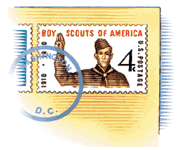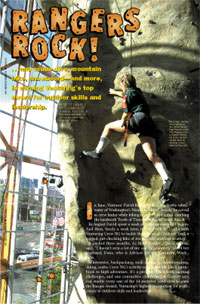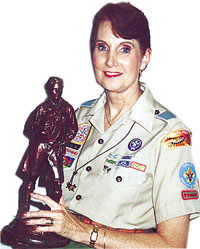![]() January-February 2000
January-February 2000


I read with interest your article on the Ranger Award and Venturing in the November-December issue of Scouting magazine. I was dismayed, however, to see the photograph of Erica Taylor on a climbing wall [and] not wearing a helmet.
A number of Scouting publications clearly specify that all participants in climbing activities of any kind shall wear a helmet. There are no exceptions.
I am the Advisor for Venturing Crew 1413 in Woodbridge, Va. I am also an experienced climber with more than 30 years in rock-climbing, alpine climbing, and high-altitude mountaineering. I wear a helmet and so does everyone in Crew 1413.
Tony Pidgeon
Montclair, Va.
David Bates, director of camping and conservation, Boy Scout Division, responds: "I applaud your safety consciousness; however, when there is no danger of falling objects, it is not necessary for a climber to wear a helmet.
"A climbing helmet is designed to protect a climber from falling objects, not from slips or falls. If a climber slips, a bolt hanger or climbing mold may strike him or her on the chin, face, or ear, and not the top of the head. If an edge of the helmet were to catch on such an object, a more severe injury could result."Certainly in most climbing situations, a helmet is a prudent precaution, especially where there is any danger of falling objects—rock, climbing hardware, rope, etc. You are wise to require helmets for your Venturing crew; however, most climbing gyms do not require climbers to wear a helmet. This is a widely accepted practice based on risk assessment."
[Editor's note: For more information, read Topping Out (BSA Supply No. 3207). This new BSA publication (available in February 2000) recommends techniques for setting up and carrying out a top-roping program that is appropriate for most BSA youth and units. It applies to climbing facilities such as towers, vertical and horizontal walls, as well as to natural features such as cliffs and rock faces.]
The October 1999 article "Skunk Train to Yesterday" described what we feel is a truly special relationship, one our council has shared with the California Western Railroad—the Skunk Train—since the opening of the council's Camp Noyo in the Redwoods of northern California in 1931.
The only access for Scouts to the 79-acre Camp Noyo is a 16-mile ride on the historic Skunk Train from the coastal town of Fort Bragg. (More than 30 years ago the Skunk Train's current senior steam locomotive engineer enjoyed his first railroad experience as a Boy Scout riding the train to Camp Noyo.)
Special train rates are available for Scouts and leaders using Camp Noyo or our nearby 80-acre Camp Masonite Navarro (which offers a full range of facilities, including summer camp). The train ride is also a good day trip for Scouts who use Masonite Navarro as a base for a longer-term camping experience on the Coast or who combine a train trip with a backpack trek on our recently completed bicycle and hiking trail between the two camps.
Our relationship with the Skunk Train continues to strengthen, with the formation of a railroading Explorer post and also through the railroad assisting the council with our marketing efforts. And last year, our council's special national Scout jamboree shoulder patch included a depiction of the Skunk Train.
Gary Milliman
Vice President, Public Relations
Redwood Empire Council
Fort Bragg, Calif.
Knowing that people let magazines pile up or throw them away, I decided to organize a magazine drive as an economical and effective pack service project ... a kind of "Scouting for magazines."
And people welcomed the opportunity to remove old magazines from their homes, especially if they knew others would get to enjoy them in some way.
We sent the ones we collected to some group homes for mentally challenged adults, to area Head Start preschools, to elementary schools for use in art classes, and to a juvenile detention center for use as incentive awards.
The project cost us next to nothing—just a little work and a ball of string to tie up the magazines.
Jeanie Ransom
Webelos Den Leader, Pack 986
O'Fallon, Mo.
I really enjoyed "Hams in the Family," the Family Together feature in the September issue.
Amateur radio is truly a hobby the entire family can do together, whether talking worldwide on the HF bands, participating in a local public service event, or just staying in touch during a Scout activity like a hike or camp-out.
And contrary to what many believe, it doesn't take a wad of cash to get started. To reiterate information contained in the article, a first step is to contact the American Radio Relay League (ARRL) at (800) 326-3942 or newham@arrl.org and ask for the free package "E-2." (In addition, I will respond to comments and questions sent to kc0erw@arrl.net.)
Again, kudos from this Eagle Scout for a well-written, informative article that did our hobby justice!
Bill Montz Jr., KC0ERW
Committee Chairman, Pack 276
ARRL Area Emergency Coordinator
Tecumseh, Neb.
I am 83 now and have been in Scouting for 71 years. I especially enjoyed the story of Detroit's Troop 194 in the September issue, because my own troop in Baker, Ore. (Troop 1, later renumbered Troop 131) was formed about the same time [and] has shared in producing outstanding young men just as Troop 194 has done.
The picture with the article showing the 1937 National Scout Jamboree flag hit a tender spot in my memory. I [was scheduled to attend] the first national jamboree in 1935 [but it was canceled due to an outbreak of polio in the Washington, D.C., area]. On our jamboree trip, however, my Eagle Scout badge was pinned on me by the Mayor of New York City.
Hollis D. Brown
Citris Heights, Calif.
Your 1935 jamboree experience sounds similar to that of other Scouts from the western United States. With the last-minute jamboree cancellation, they set out on alternate journeys, visiting cities like Chicago and New York on the way eastward, or touring other parts of the country. The Way It Was column titled "Two Great Non-Jamboree Journeys," in the May-June 1997 Scouting magazine, describes the 1935 traveling adventures of groups of Scouts from Oregon and California.
We recently finished yet another Scoutmastership Fundamentals outdoor weekend, the culmination of a successful training course.
I believe the 13 or more members of our district Boy Scout training team are second to none. We recruit a few new staff members every year to keep our training program fresh and innovative; some move on after a few years and some stay on. Each year we recruit a new senior patrol leader for our outdoor weekend course, and the following year that person steps into the Scoutmaster position.
At the end of the weekend, several participants will come up to thank us for putting so much time into the program and into Scouting in general.
My reply to them is: "There is nothing better I could be doing, and no better people I could be doing it with."
Pat Gibbons
Appalachian District Boy Scout Training Staff
Northeastern Pennsylvania Council
Scranton, Pa.
 Museum room was Sidna Small's "ticket." |
After our two Eagle Scout sons went off to college, I thought my Scouting days were over. Then in 1993 the Quivira Council in Wichita, Kan., asked me to serve on its executive board. And in 1995 I was asked to serve as chairman of my local district.
I made my first trip to Philmont Scout Ranch in 1996 for District Key 3 leadership training and fell totally in love with the mountains—and with my job in Scouting, as well. (I have since gone back for two more Philmont training sessions, each one better than the last.)
At the 1997 National Scout Jamboree at Fort A.P. Hill in Virginia, I served on subcamp transportation staff. What a wonderful job—long hours in extreme heat, but a chance to meet many of the 35,000 Scouts and Scouters attending the jamboree.
In 1998, I enrolled in the Heart of America Council's Scoutmaster Wood Badge course...My "ticket" (the personal project required to complete Wood Badge training) included establishing a Boy Scout room in the Independence Museum in Independence, Kan.
Many Scouter friends shared their treasures for the display—a 1960 Air Squadron uniform, a Sea Scout uniform that sailed to Cuba in the early 1950s, buckles, patches, jamboree souvenirs, and much more.
I will add that, as a woman, I have always been treated with respect and total acceptance, both as a friend and as a female in the Scouting world ... I was the only woman enrolled in my Wood Badge course, [but] I felt accepted by everyone, especially by my fellow patrol members; the women in my Philmont classes have had a fun time and have been accepted, listened to, and have often taken the group leadership role.
I want other women to realize that they, too, can help to fill leadership positions that occur in their town, district, or council.
God has richly blessed me, [and] whatever I have given to Scouting has come back to me a hundredfold (District Award of Merit, Silver Beaver, Religious Award).
It is such a joy for me to help to promote the Boy Scout movement in Kansas and in America. And, yes, my application to be a staff member at the national Scout jamboree in 2001 is already in.
Sidna Small
Neodesha, Kan.
The September article on The Boy Scout Handbook indicated that both the 5th edition and the 8th edition had two different covers. I am curious if the covers changed with various printings or if there is another explanation.
Neither of these editions of the handbook was current during my time as a Boy Scout. From my entrance into Boy Scouting in early 1960 until I achieved Eagle Scout in November of 1962, the 6th and 7th editions were the handbooks vital to my success in Scouting.
Steven D. Ingersoll
Dayton, Nev.
The six million copies of the 5th edition (1948-1959) represent the largest printing of any Boy Scout Handbook to date. Most of these (5,160,000) featured the second version of the cover, which reflected postwar changes in the Scout uniform, an overseas cap having replaced the larger campaign hat as standard headgear.
However, for the 8th edition (1972-1979), the action-oriented second cover didn't replace its predecessor until 1976 and appeared on only 950,000 of the edition's total printing of 3,700,000 copies.
In the September 1999 issue of Scouting magazine, I realized that two especially interesting articles were both by Robert Peterson. Then in the October issue I found myself reading another interesting article ... by Robert Peterson. And I discovered that the always highly readable Front Line Stuff column is also edited by Robert Peterson.
[I realized that the articles by] my longtime Scouting friend Bob Peterson, who has been a regular contributor to your magazine for many years, have always been good material for Scout leaders and boys. He certainly deserves special recognition.
C. B. Young Jr.
Committee Member, Troop 31
Ramsey, N.J.
You will find two more articles by contributing editor Robert Peterson in this issue: "Celebrating 90 Years of Strong Values and Leadership" and "Hands-On Science for Cub Scouts."
Bob Peterson's association with Scouting magazine first received special recognition when his name appeared as a contributor on the masthead in 1970. Since then he has produced countless articles for both Scouting and Boys' Life, as well as merit badge pamphlets and other materials for the Boy Scouts of America.
Two historical articles—about this magazine ("The 85-Year Trail of Scouting Magazine") and about The Boy Scout Handbook ("The Perfect Book for a Desert Island")—are part of Scouting's section of the official BSA Web site (http://www.scouting.org). Books written by Robert Peterson include The Boy Scouts: An American Adventure (which is, unfortunately, now out of print), and Only the Ball Was White: A History of Legendary Black Players and All-Black Professional Teams (Gramercy, hardcover; Oxford University Press, paperback).
Each issue of Scouting magazine is an excellent source of inspiration, information, and history. And I believe the September 1999 Family Talk column by Victor Parachin ("Broken Ties: Ways to Help Kids Deal With Divorce") may contain the best step-by-step approach to dealing with broken families of divorce.
As a guidance counselor of two primary schools, I witness each day the struggles involving shared custody and visitation ... Parachin's article concisely presents some of the more effective tips, steps, and strategies for working out a difficult situation. ...
William Martin
Committee Member, Troop 20
Belton, S.C.
| The Boy Scouts of America | http://www.scouting.org |